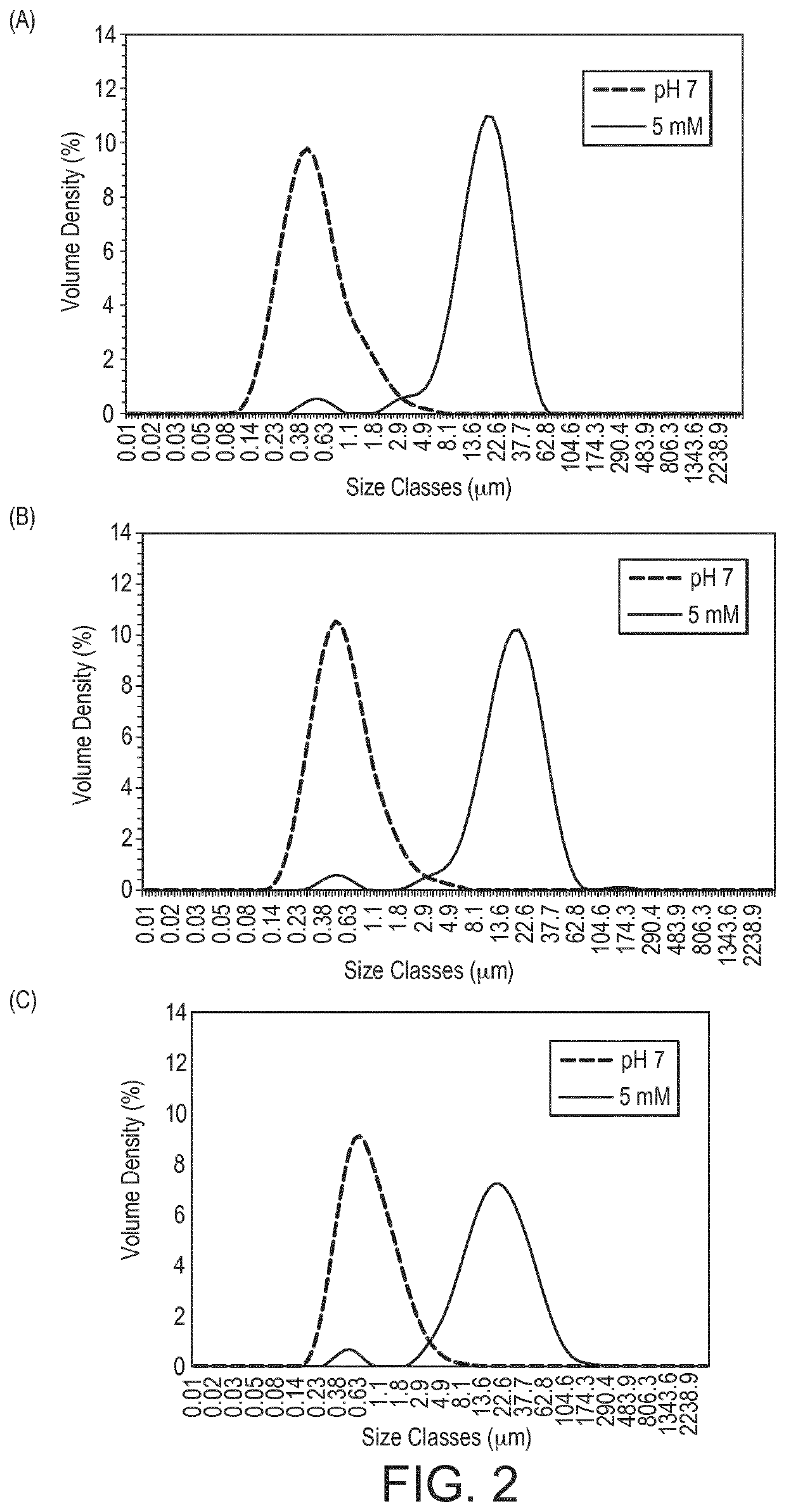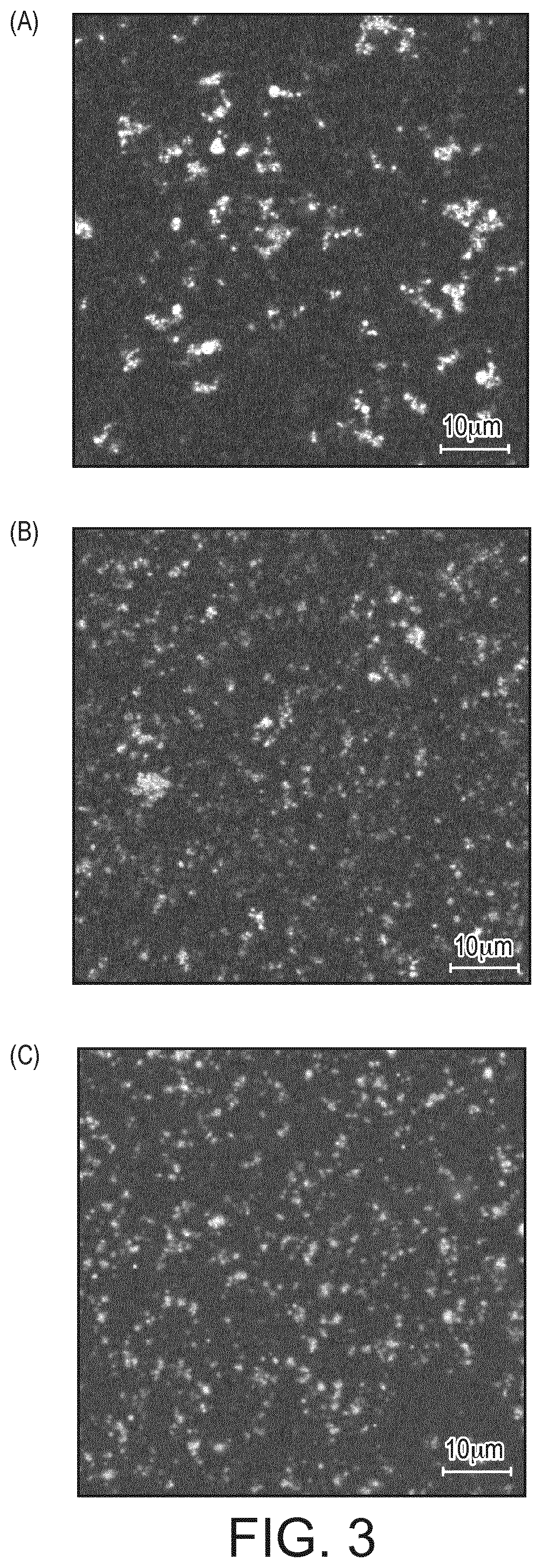A method of producing a food or beverage product with free divalent cations protein aggregation
a technology of divalent cations and applied in the field of producing food or beverage products, can solve the problems of unstable product, unsatisfactory gel formation in many semi-solid food and beverage products, and inability to produce gel, so as to improve texture and mouthfeel
- Summary
- Abstract
- Description
- Claims
- Application Information
AI Technical Summary
Benefits of technology
Problems solved by technology
Method used
Image
Examples
example 1
[0068]Milk Protein-Based Aggregates Obtained by Calcium Chloride Addition in Heated Full Fat Milk.
[0069]Material and Methods
[0070]Chilled pasteurised and microfiltered full fat milk (3.5 wt. % fat) was provided by Cremo S.A. (Le Mont-sur-Lausanne, Switzerland). It had an initial pH of 6.77 as measured at 25° C. For calcium addition a solution of CaCl2), 2(H20) (Merck, Darmstadt, Germany) was prepared at 200 mM in MilliQ water. A volume 50 mL of milk were introduced in a Pyrex glass bottle of 50 ml (Schott Duran type, Germany) for each calcium chloride solution addition to cover a free calcium addition ranging from 1-16 mM. Magnetic stirring was performed 300 rpm and at room temperature 20-23° C.
[0071]After calcium chloride addition, 20 mL of milk were introduced in a 22 mL sealed glass tube containing a magnetic barrel. The closed tubes were partially (⅔) immerged for 15 min in a water bath regulated at 92.5° C. in order to reach a product temperature of 90° C. in 3 minutes. The inc...
example 2
[0076]Calcium Addition in Milk Protein Concentrate Stabilized Emulsions
[0077]Material and Methods
[0078]The stock solution of micellar caseins dispersion was prepared at a protein concentration of 10 wt. %. Micellar caseins concentrate Promilk852B (batch 13610656) was purchased from Ingredia (Arras, France). The powder composition was (g / 100 g wet powder): protein (Nx6.38) 82.3, Ca 2.6, Mg 0.1, Na 0.07, K 0.29, Cl 0.05, P 1.56. The mass of powder needed to prepare the dispersion was calculated as a function of the protein content in the powder.
[0079]Micellar casein powder was hydrated in MilliQ water for 3 hours under stirring at the room temperature. After 3 hours, the protein dispersion was homogenized with an EmulsiFlex C-5 high pressure, single-stage homogenizer (Avestin®, Canada). This treatment decreased the average particle size of micellar caseins and the amount of non-sedimentable caseins (κ, αs1; and αs2) in serum increases, it allows to stabilize the solution and avoids th...
example 3
[0123]Calcium Addition in Double Concentrated Milk, Heat Treatment and Spray Drying
[0124]Material and Methods
[0125]A set of 2 samples were produced according to the following procedure, involving: concentration of a commercial whole milk to 35% total solids (TS) content, adding a variable amount CaCl2) (5 and 10 mM) in the milk concentrate, standardized heat processing including a direct steam injection step, and spray drying to obtain a functionalized milk powder.
[0126]Commercially available, pasteurized and microfiltered, homogenized whole milk (3.5% fat content, Cremo, Le Mont-sur-Lausanne, CH) is concentrated to a total solid content as indicated in the table 2, with a Centritherm® CT1-09 thin film spinning cone evaporator (Flavourtech Inc., AU).
[0127]The concentration process is done in recirculating batch mode, starting with milk at 4° C. The milk is pumped with a progressing cavity pump, from a buffer tank through a plate heat exchanger set to 40° C. outlet temperature and th...
PUM
 Login to View More
Login to View More Abstract
Description
Claims
Application Information
 Login to View More
Login to View More - R&D
- Intellectual Property
- Life Sciences
- Materials
- Tech Scout
- Unparalleled Data Quality
- Higher Quality Content
- 60% Fewer Hallucinations
Browse by: Latest US Patents, China's latest patents, Technical Efficacy Thesaurus, Application Domain, Technology Topic, Popular Technical Reports.
© 2025 PatSnap. All rights reserved.Legal|Privacy policy|Modern Slavery Act Transparency Statement|Sitemap|About US| Contact US: help@patsnap.com



